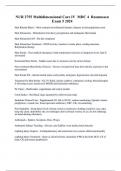NUR 2755 Multidimensional Care IV MDC 4 Rasmussen
Exam 5 2024
Heat Related Illness - Most common in hot/humid climates, Impacts at risk populations most
Heat Exhaustion - Dehydration from heavy perspiration and inadequate fluid intake
Heat Exhaustion S/S - Flu like symptoms
Heat Exhaustion Treatment - STOP activity, transfer to cooler place, cooling measures,
Rehydration therapy
Heat Stroke - True medical emergency, body temperature increases to dangerous level, fatal if
not treated
Exertional Heat Stroke - Sudden onset due to strenuous activity in hot climate
Non-exertional Heat Stroke (Classic) - Occurs over period of time from chronic exposure to hot
environment
Heat Stroke S/S - altered mental status, tachycardia, tachypnea, hypotension, elevated troponin
Treatment for Heat Stroke - O2, IV fluids, urinary catheter, continuous cooling, benzodiazepine
if shivering occurs, monitor for MODS and electrolyte imbalance.
Pit Vipers - Rattlesnake, copperheads and cotton mouths
Coral Snakes - Red black rings separated by yellow/cream rings
Snakebite Clinical Care - Supplemental O2, LR or NS IV, cardiac monitoring, Opioids, tetanus
prophylaxis, wound care, broad spectrum antibiotics, CBC, CK, crossmatching
Post Snakebite - Keep below level of heart, remove constrictive clothing, laydown, stay calm,
keep site clean, immobilize site, no tourniquet, don't cut/suck venom, no ice, do not submerge,
no mind altering substances
Arthropods - Spiders, Scorpions, Bees, Wasps
Arthropod Allergy Teaching - Always carry EpiPen, wear medical alert bracelet
Lighting Injury Impacts - Cardiopulmonary and central nervous systems affected profoundly
Lighting Injury Treatment - Same as electrical burn, immediate CPR in the field, ECG, CT of
head, CK and tetanus prophylaxis




